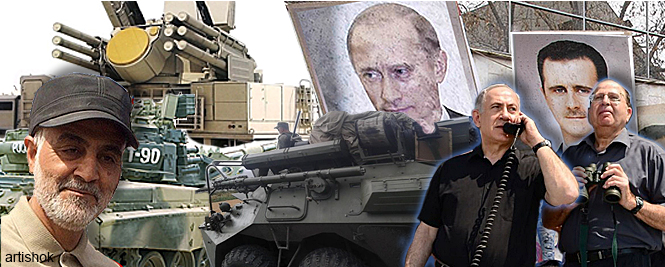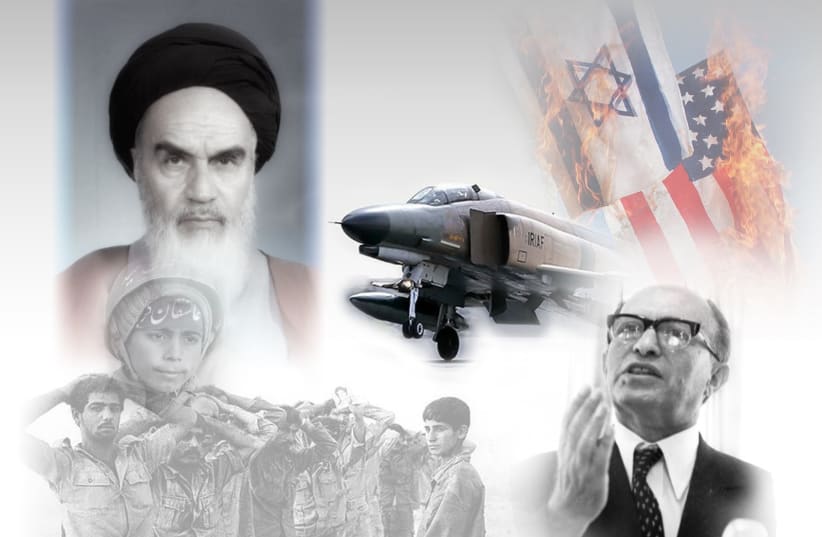America enters the “Old Middle East”
Eyad Abu Shakra/Asharq Al Awsat/September 1/15
What does Russia want from what remains of Syria? Well, one thing is for sure: any bet that Moscow may be willing to implement the Geneva Documents—even according to the interpretation of Vladimir Putin and his diplomatic “commissar” Sergey Lavrov—is naïve to say the least. The current political climate in the Middle East is not only suitable, but encouraging for Moscow to flex its muscles.It is not every day that a president like Barack Obama occupies the White House; and, as long as Obama continues to make the alliance with Iran the focus of his “political legacy,” while his Republican opponents fail to come up with an alternative and meaningful Middle East policy, Washington’s room for maneuver in the region will be limited, and belatedly reactive.
Some claim that behind Obama’s insistence on securing the nuclear deal with Iran is a “carrot and stick” strategy. This means he is betting on improving the chances of a pragmatist “reformists” victory against the “conservative” Mullahs and the Islamic Revolutionary Guard Corps leadership, and bartering Iran’s nuclear weapons with regional influence granted to it at the expense of its neighbors. Such a scenario is of course possible given the relatively large number of pro-Israel senators whom the White House managed to “convince” and win over, and the “satisfied” silence of Israel’s military and security establishment which—as reported recently—rejected more than once Benjamin Netanyahu’s prodding to attack Iran. If the reformist camp does manage to win—as Obama seems to believe it will—I reckon Moscow would have some sort of “arrangement” that would guarantee it enough influence near Russia’s southern borders and in the eastern Mediterranean.
Putin is a politician and former intelligence officer whose political identity matured in the thick of the Cold War and the East–West confrontation. He later witnessed the humiliation suffered by the defeated, and consequently fragmented, USSR at the hands of a jubilant and disrespectful West. Thus, as the slogans of “Socialism,” “Humanity,” and the “Right of self-determination” lectured to us by the old Pravda are today only entertained by imbeciles of the childish Left and traded by “intelligence service Arabists,” one must realize that we are dealing with a “neo-Tsarist” Russia.America’s inaction towards the Syrian uprising has been the green light that reassured Putin that he could do what he pleased, whether in Crimea or eastern Ukraine. Today, we are back at full circle; and, again, Washington is reiterating that it is only interested in reassuring Iran and Israel, even if the price is alienating Turkey and the Arabs.
Neo-Tsarist Russia will never forget the Middle East, where old Tsarist Russia had prominent consuls, monasteries, “seminars,” and “Muscovite” schools. And while France thought of itself as the guardian of Catholics and Maronites in the region, and Britain and later America became active in spreading Protestant institutions, Russia became the protector and guide of the Orthodox community in the Middle East. So, Putin’s Russia, now that Socialism is a profitable commodity no more, is reverting to its Tsarist past, and why not? It is powerful enough not to seek approval, or permission, from anyone to fight the “political Islam” it has fought against for centuries throughout its vast lands and along its long borders extending from the Balkans, through the Caucasus, to central Asia.
There is also another side to the story, this time linked to Russia’s erstwhile tactical alliance with Iran. A few months ago a rumor began to spread that senior Iranian leaders informed a high-ranking Syrian regime official visiting the country that Iran “has paid and continues to pay a lot” in defending Bashar Al-Assad’s regime. They added that Iran needs as collateral lands they have already chosen inside Syria, valued close to their estimate of what Tehran has already spent on the conflict—26 billion US dollars. Upon his return, the Syrian official reported to Assad what he had heard in Tehran. Assad reacted to the Iranian message—so the rumor goes—by contacting a number of Syrian Christian notables and informing them bluntly that the Iranians “want to take over the country,” and that he was in no position to protect them; thus he may need to rely on Russia!
This rumor was published in the Middle East, but like most rumors no one is willing to own up or give credence to, it soon faded and disappeared. Still, the way Iran is managing the war in Syria through its Revolutionary Guards—including its sectarian Lebanese, Iraqi, and other Shi’ite militias—in Zabadani, the Qalamoun Mountains, Hauran, and northern Syria, and its central role in negotiations concerned with population exchange, confirms that it is fully in charge. Yes, Iran is now actually and effectively running the “useful Syria,” leaving Assad as a mere figurehead. This means that the pre-March 2011 Syria is finished and gone regardless of what happens to Assad and the skeleton of his moribund regime. It also means that if Turkey finds itself forced to pre-empt the establishment of an independent Kurdish entity along its southern border with Syria, extending from northern Iraq to Turkey’s Hatay Province, Russia may decide it wouldn’t be a good idea after all to relinquish its influence in Syria to Iran; more so if victorious Iran’s “reformists” become Washington’s allies. In the meantime, Washington has just “discovered” that after being quite busy envisaging a “New Middle East” it seems to be looking the “Old Middle East” in the face!
In an assessment that is at odds with official Obama administration policy, Lt. Gen. Vincent Stewart, the head of the Defense Intelligence Agency, said recently at an industry conference that Iraq and Syria may have been permanently torn asunder by war and sectarian tensions, adding that “I’m having a tough time seeing it [Iraq and Syria] come back together.” On Iraq, Stewart said he was “wrestling with the idea that the Kurds will come back to a central government of Iraq,” suggesting he believed it was unlikely. On Syria, he said: “I can see a time in the future where Syria is fractured into two or three parts.” That is not the US goal, he said, but it’s looking increasingly likely. CIA Director John Brennan, speaking on the same panel, meanwhile said: “Iraqis and Syrians now more often identify themselves by tribe or religious sect, rather than by their nationality . . . I think the Middle East is going to be seeing change over the coming decade or two that is going to make it look unlike it did.”Brilliant “discoveries” indeed. Pity they do not surprise monitors of Washington’s policies anymore!
Russian troops already engaged in battle against ISIS around Homs
DEBKAfile Exclusive Report September 17, 2015
Contrary to the impression conveyed by Moscow that Russian troops in Syria are not engaged in combat and that none of the sophisticated arms deliveries were destined to the Syrian army, new developments belie both these claims. debkafile’s military and intelligence sources report that on Wednesday, September 16, Russian R-166-0.5 (ultra) high-frequency signals (HF/VHF) vehicles were spotted on Highway 4, which links Homs and Aleppo. These vehicles, called “mobile war rooms” by the IDF and Western armies, were accompanied by BTR-82 troop carriers transporting Russian marines. The R-166-0.5 enables communication with forces located on battlefields as far as 1,000 kilometers away using high frequency and ultra-high frequency signals.
The communication systems are resistant to electromagnetic jamming so Russian forces operating deep inside Syria can report to their commanders at the main Russian base in Latakia or receive orders, intelligence data and even video from drones or planes. Another feature is a cylinder on the side of the vehicle containing a folded antenna that can be raised to a height of 15 meters. The R-166-0.5 is an integral part of Russia’s battlefield operations, so it would not be deployed unless long-distance troop movements were underway. The appearance of those vehicles in the Syrian theater provides a clear signal of Moscow’s intentions.
Our sources point out that during the past few days, fighters from the Islamic State in Iraq and the Levant (ISIS) succeeded in cutting off part of the highway between Homs and Aleppo for several hours. It marked a very dangerous development for the Syrian army and regime, because a permanent cutoff of Highway 4 would tighten the siege on Aleppo and possibly pave the way for the conquest of the second-largest city in Syria.
The movements by the armored vehicles show that the Russian troops are preparing to head into battle in order to prevent such a scenario. Moscow has denied supplying new, sophisticated weapons to the Syrian army. However, a Syrian military source revealed Thursday, Sept. 17, that the Syrian military has recently started using new types of air and ground weapons supplied by Russia, underlining growing Russian support to Damascus that is alarming the United States and Israel. “New weapons – and new types of weapons – are being delivered,” said the source which described them as “highly accurate and effective.” The army had started using them in recent weeks having been trained in their use in Syria in recent months.
“We can say they are all types of weapons – be it air or ground,” he said. debkafile’s military sources reveal that the Russian shipments for the Syrian army include MI-28 MIL assault helicopters (NATO-coded Havoc), an all-weather aircraft, which can also serve as an anti-tank weapon against the mostly US-made tanks fielded by ISIS and Al Qaeda’s Nusra Front Syrian arm. Our military and intelligence sources point out that Moscow has given itself room to maneuver in terms of its declared goals, telling Washington and Jerusalem during the past few days that its troops will defend their own interests if there is a need to do so. Thus, Russia aims to use its forces in any way that it deems fit.debkafile’s sources in Washington report an ongoing debate within the Obama administration regarding whether to accept the proposal that was raised during the telephone conversations this week between Russian Foreign Minister Sergei Lavrov and US Secretary of State John Kerry.
Moscow proposed military-to-military talks on ways to prevent a confrontation between its troops in Syria and those of the US-led coalition, saying that the talks would provide a complete and clear understanding of Moscow’s intentions. Unlike Kerry, who is in favor of taking the Russians up on their proposal, some circles in the administration feel that such talks would ultimately give Russia the green light for its military involvement and that Moscow is in the process of grabbing control of running all military operations in Syria, including those by other countries and groups. Last week, Gen. Qassem Soleimani, commander of Iran’s al-Quds brigades, visited Moscow for the second time since April. debkafile’s sources in Moscow point out that this time, unlike his previous visit, Soleimani met with Russia’s National Security Adviser Nikolai Patrushev and a number of generals directly connected to the buildup in Syria, but not with President Vladimir Putin.
The developments in Syria will also take center stage when Israeli Prime Minister Benyamin Netanyahu meets with Putin in Moscow on September 21.




















